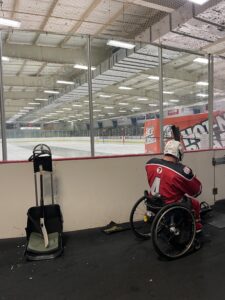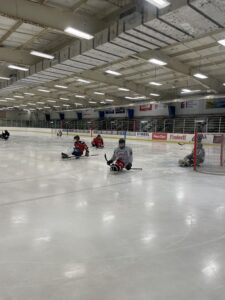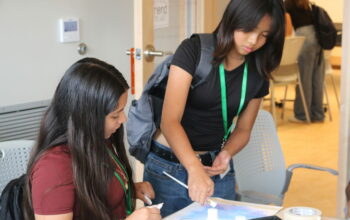Twelve players artfully glide across the freshly smoothed ice as the orange Little Caesar’s Zamboni exits the rink. Bashing into the boards, carving with each turn, just like any ice hockey game — except this is sled hockey.
Joe Fitzgibbon, a pillar in the sled hockey community, has been playing the sport for almost 20 years.
“It’s a hockey thing, that if the bug bites you, it sticks with you,” Fitzgibbon said.
Sled hockey is ice hockey adapted to fit the needs of people with physical disabilities. The sport is played with players seated in a bucket seat that lies on top of double adjustable blades. The players then use two sticks that are outfitted with picks on one side to propel themselves forward and blades on the other to maneuver the puck.

Madison has always been a hockey town, but it is also home to the state’s first sled hockey teams: a youth team, the Skeeters, and an adult team,the Sting, both started in the early 2000s at Madison Ice Arena on the city’s west side. The arena houses not only sled hockey for both youth and adults, but also youth and adult special hockey and a program called adaptive learn-to-skate.
A founding member of the original Skeeters team, Fitzgibbon also helped to kickstart the Sting, which he now plays for. Like many Wisconsin natives, he grew up in a hockey-crazed family. However, he was unable to participate when he was younger because of the lack of adaptive options and accessibility, until the Skeeters. As one of Madison’s original sled hockey players, Fitzgibbon has seen just how much the sport has grown.
“It's an interesting time in sled hockey. It has exploded compared to when we started,” Fitzgibbon said.
In the Skeeters’ early days, they had no one to practice or compete with. So, they would reach out to older youth teams that played stand-up hockey and ask them to scrimmage. They would then provide the equipment for their team and teams of players without disabilities to play and practice. Although the stand-up teams typically treated this as a team-bonding activity, the Skeeters needed ice time and would take any opportunity to compete.
Now, the Skeeters and Sting host weekly joint practices on Sunday afternoons and travel regionally to play teams in Milwaukee, La Crosse and Green Bay, as well as teams outside of Wisconsin.

A newer addition to the team, Aditi Kharabe moved to Madison to work at Epic a year ago. Kharabe was not born with a disability but was diagnosed with Bronchiolitis Obliterans, an illness that restricts her lung capacity to 30%, at the end of high school. Though she did not grow up playing hockey, it is now the highlight of her week, she says.
“There aren’t really a lot of people I can relate to, people who understand what's going on, but here it's a surprising amount of understanding,” Kharabe said. “We’re all just here to play sled hockey and everyone is equal on the ice.”
Kharabe typically doesn’t enjoy exercising because of the strain it puts on her illness, but says sled hockey is fun and has given her a community to connect with and the opportunity to further explore her identity.
Currently, the Sting don’t have enough permanent players to fill out a full squad. But the much more developed youth team, the Skeeters, do. During their regular season, the Skeeters compete and travel to games across the Midwest and, once a year, the team competes in a national championship.
For the 2024 season, they will travel to West Chester, Pennsylvania, in April to compete against teams from across the country in the Toyota USA Hockey Sled National Championship.
When Fitzgibbon was in high school, playing on Skeeters team, the national championship consisted of a single weekend where all types of adaptive hockey (special hockey, blind hockey, single- and double-amputee and more) were grouped together in a rapid cycle of games. Now the championship has expanded to two weekends, with one weekend solely dedicated to sled hockey, played by different categories of youth and adult teams.
Amy Cassiday, mother to Skeeters team member Andrew Cassiday, had her son playing sled hockey when he was 5, more than a decade ago. Now in high school, Andrew and his mother are an integral part of the sled hockey community in Madison. It is a community built upon shared experiences and, according to Amy Cassiday, “you need people who get it.”
“Being a parent of a child with a disability can feel really isolating,” she said. “So adaptive sports really connect you. It connects young people to look and experience the world the same way we do. And it does the same thing for parents… you become really close-knit resources for each other.”
Though the sport continues to expand every year, there are many barriers to entry, including the expense of buying the gear, the cost of traveling to out-of-town championships, the difficulty of finding rinks adapted for sled use and comparatively low awareness of the sport, which is not offered through high schools.
Some teams that are in the same city as a National Hockey League team get funding through their association with the professional team. Unfortunately, Madison is not one of those teams.
So, in order to play, all Sting and Skeeters athletes need to purchase the bucket seat, which costs around $800, then cover the additional costs of the sticks, protective gear, helmets and travel that are part of the sport.
Despite the barriers, Madison’s two sled hockey teams continue to grow. On April 27, Madison Ice Arena is hosting an open house for local elementary, middle and high schools to educate teachers and schools about the available options, provide them resources for their students and potentially recruit new members to the team.
To learn more or donate, visit Southern Wisconsin Sled Hockey (skeeterssledhockey.com)






